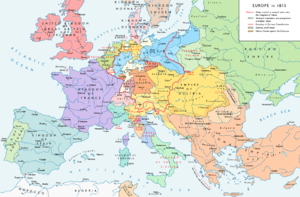
Back Kongres van Wene Afrikaans Wiener Kongress ALS مؤتمر فيينا Arabic مؤتمر ڤيينا ARZ Congresu de Viena AST Vyana konqresi Azerbaijani Венскі кангрэс Byelorussian Венскі кангрэс BE-X-OLD Виенски конгрес Bulgarian Kendalc'h Vienna Breton


The Congress of Vienna[a] of 1814–1815 was a series of international diplomatic meetings to discuss and agree upon a possible new layout of the European political and constitutional order after the downfall of the French Emperor Napoleon Bonaparte.[1] Participants were representatives of all European powers (other than the Ottoman Empire)[b] and other stakeholders. The Congress was chaired by Austrian statesman Klemens von Metternich, and was held in Vienna from September 1814 to June 1815.
The objective of the Congress was to provide a long-term peace plan for Europe by settling critical issues arising from the French Revolutionary Wars and the Napoleonic Wars through negotiation. The goal was not simply to restore old boundaries, but to resize the main powers so they could balance each other and remain at peace, being at the same time shepherds for the smaller powers. More generally, conservative leaders like Metternich also sought to restrain or eliminate republican, liberal, and revolutionary movements which, from their point of view, had upended the constitutional order of the European ancien régime.
At the negotiation table, the position of France was weak in relation to that of Britain, Prussia, Austria, and Russia, partly due to the military strategy of its leader, Napoleon Bonaparte, over the previous two decades, and his recent defeat. In the settlement the parties did reach, France had to give up all recent conquests, while the other three main powers made major territorial gains around the world. Prussia added territory from smaller states: Swedish Pomerania, most of the Kingdom of Saxony, and the western part of the former Duchy of Warsaw. Austria gained much of northern Italy. Russia added the central and eastern parts of the Duchy of Warsaw. All agreed upon ratifying the creation of the new Kingdom of the Netherlands, which had been created just months before from the former Dutch Seven Provinces together with formerly Austrian territory, and was meant to serve as a buffer between the German Confederation and France.
The immediate background was Napoleonic France's defeat and surrender in May 1814, which brought an end to 23 years of nearly continuous war. Remarkably, negotiations continued unaffected despite the outbreak of fighting triggered by Napoleon's return from exile and resumption of power in France during the Hundred Days of March to July 1815. The Congress's agreement was signed nine days before Napoleon's final defeat at Waterloo on 18 June 1815.
Some historians have criticised the outcomes of the Congress for causing the subsequent suppression of national, democratic, and liberal movements,[3] and it has been seen as a reactionary settlement for the benefit of traditional monarchs. Others have praised the Congress for protecting Europe from large and widespread wars for almost a century.
Cite error: There are <ref group=lower-alpha> tags or {{efn}} templates on this page, but the references will not show without a {{reflist|group=lower-alpha}} template or {{notelist}} template (see the help page).
- ^ Cite error: The named reference
:0was invoked but never defined (see the help page). - ^ Ozavci, Ozan (2022). "A Priceless Grace? The Congress of Vienna of 1815, the Ottoman Empire and Historicising the Eastern Question". The English Historical Review. 136 (583). Oxford University Press: 1459–1461. doi:10.1093/ehr/ceab356.
- ^ Cite error: The named reference
Olson-Shadlewas invoked but never defined (see the help page).